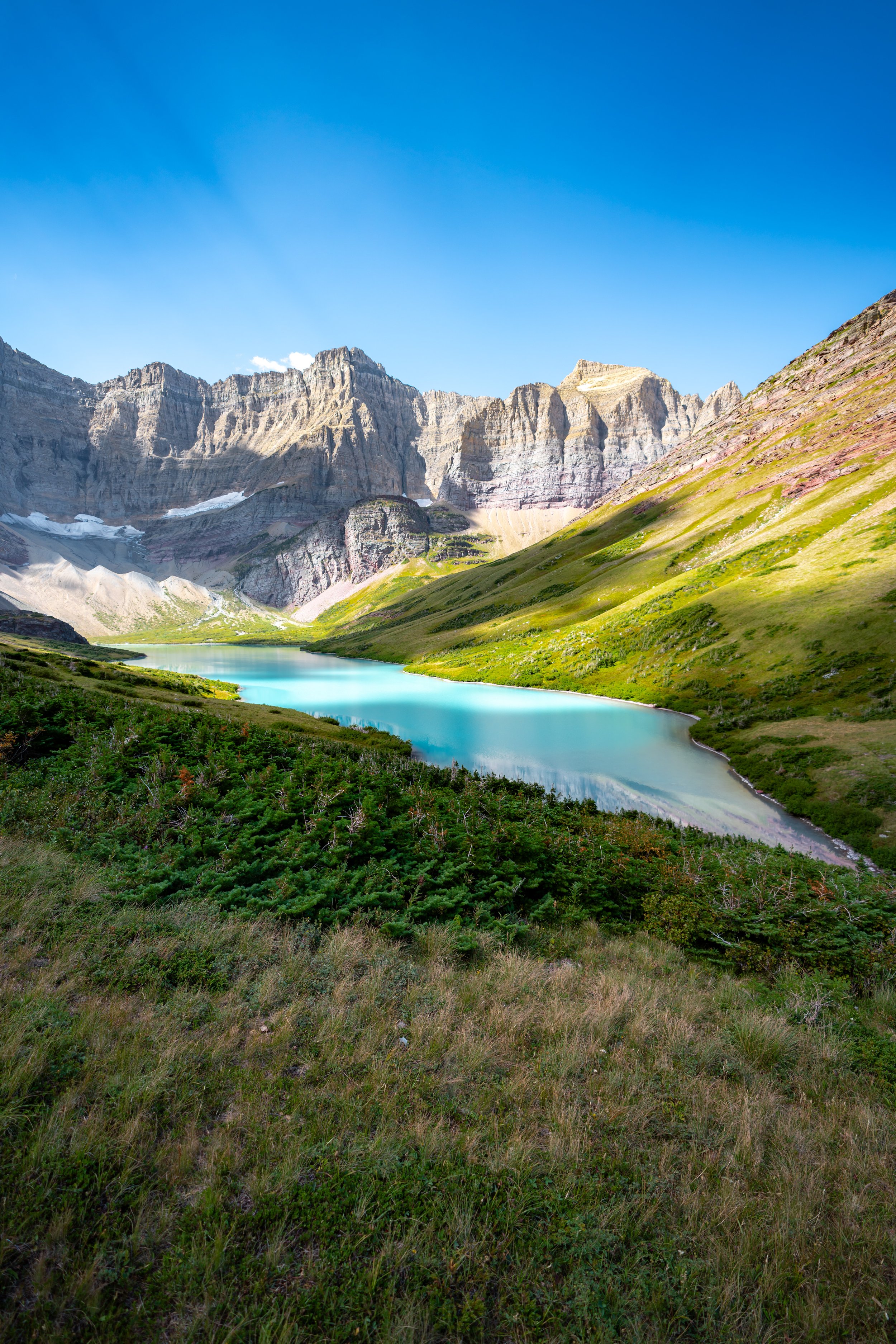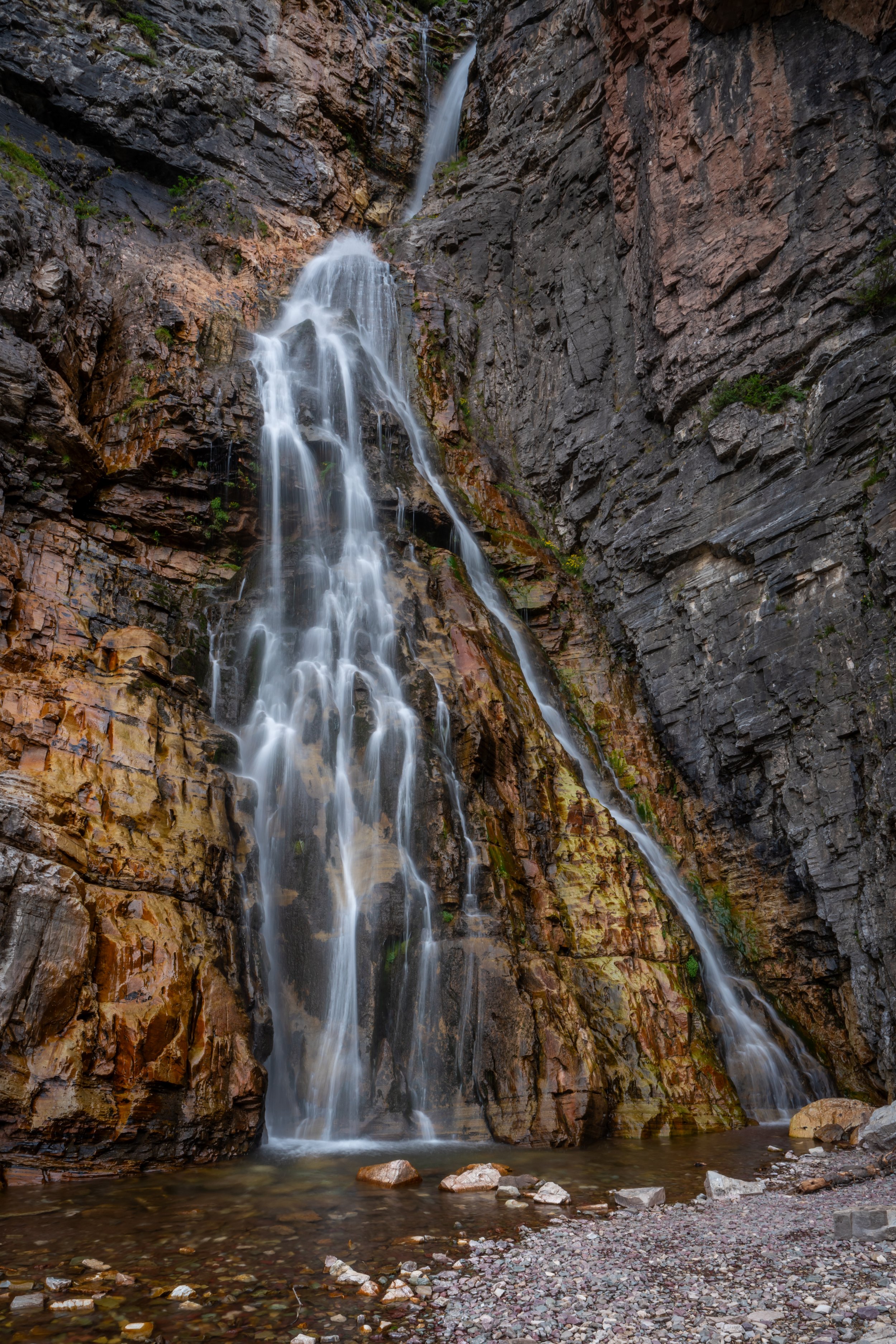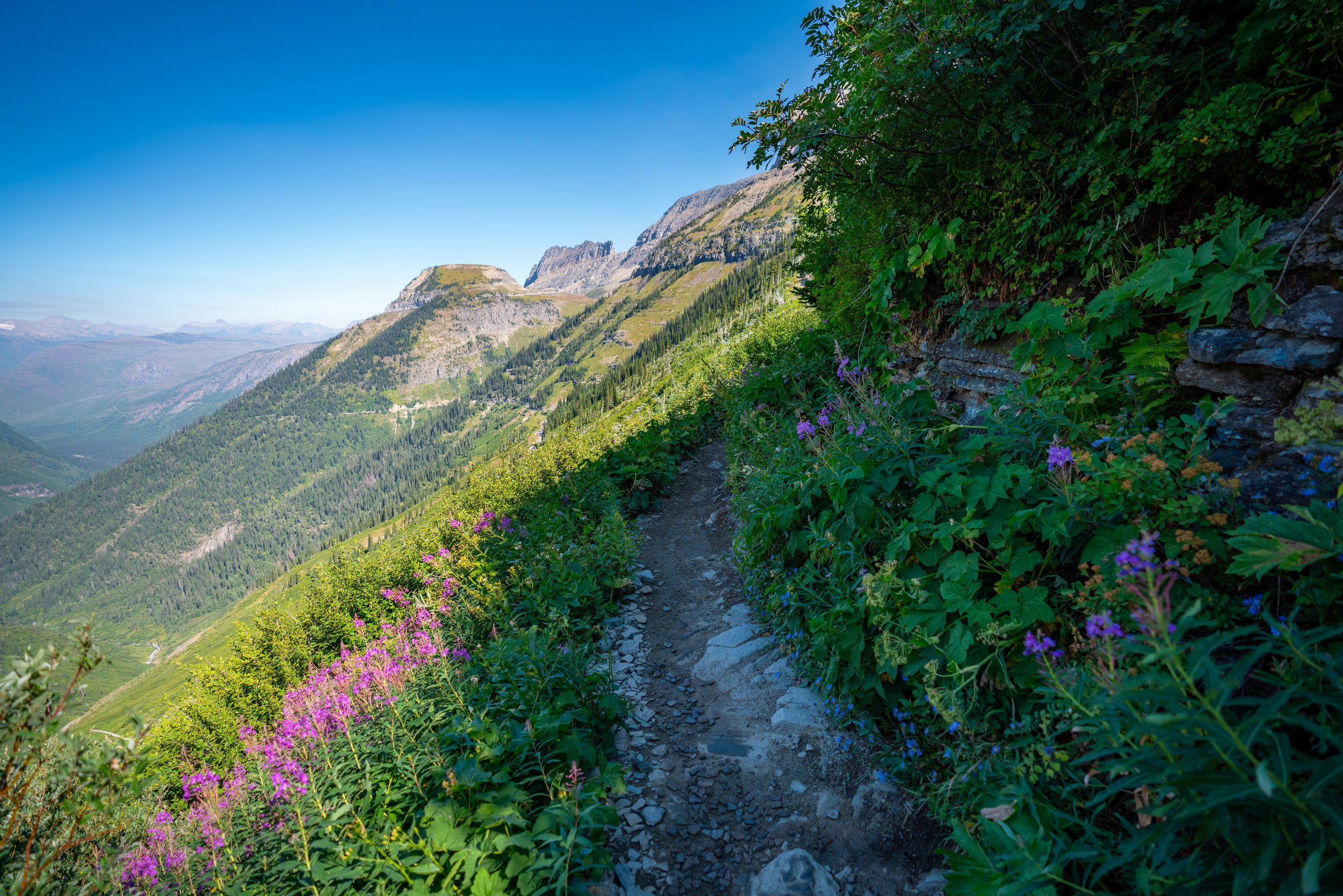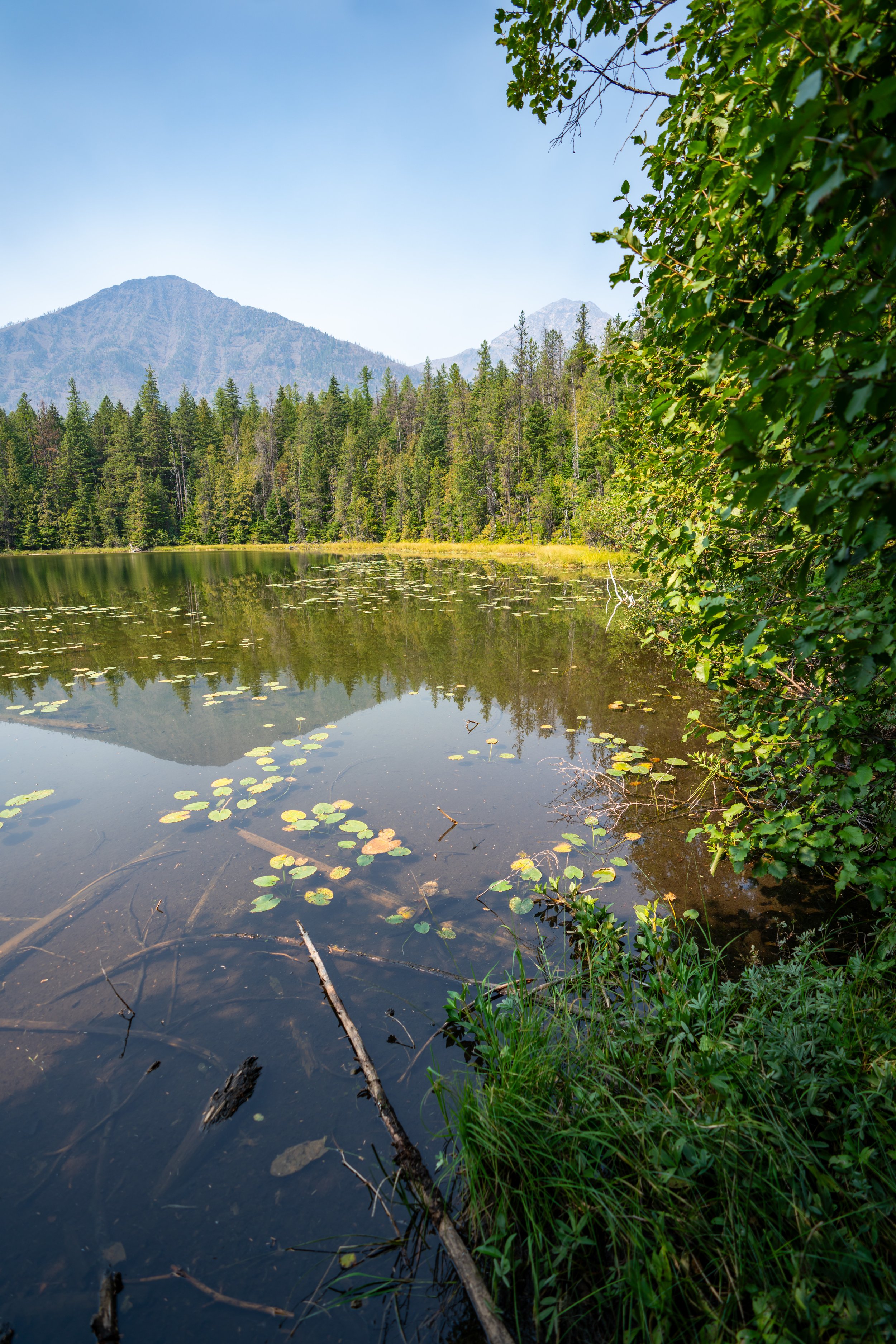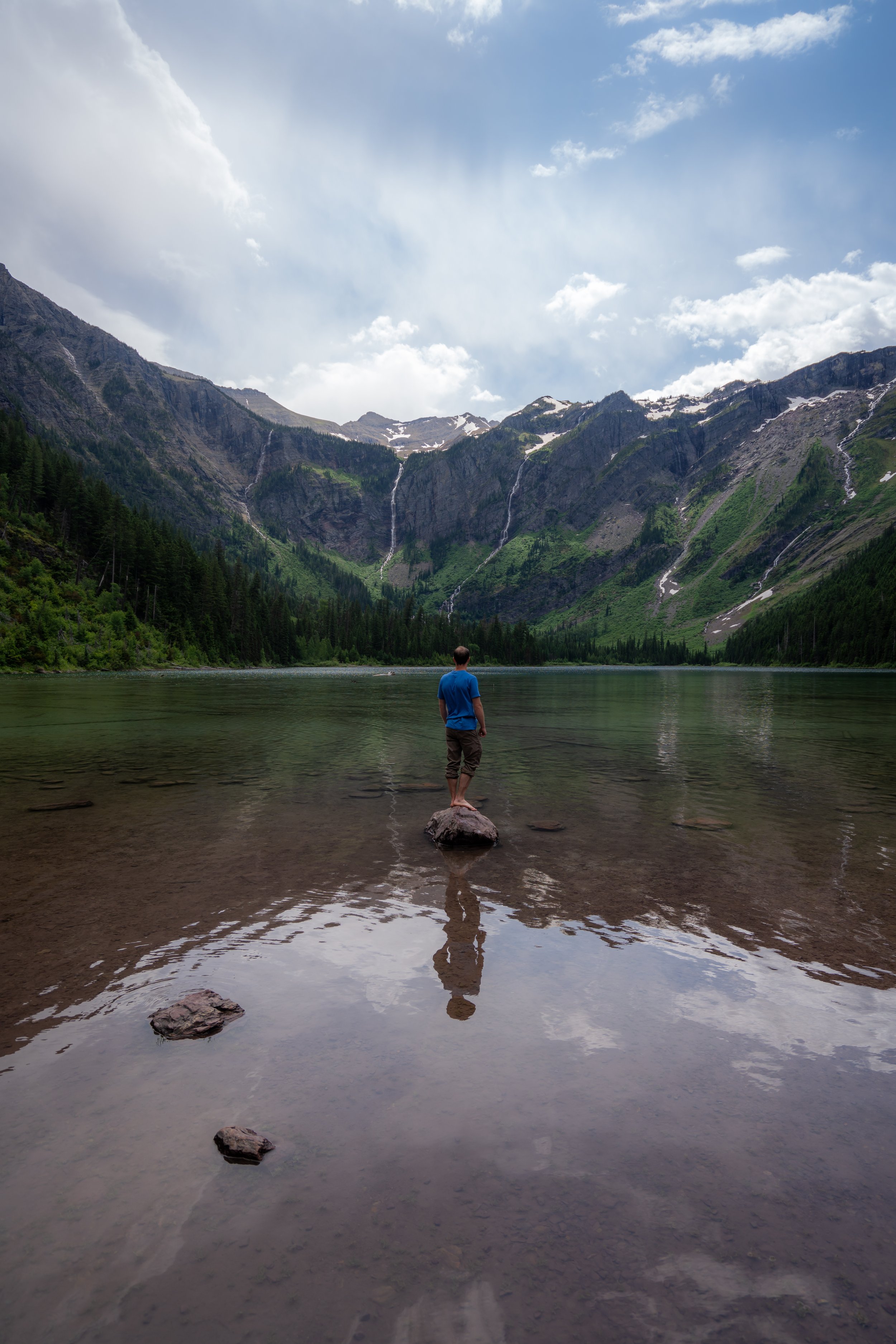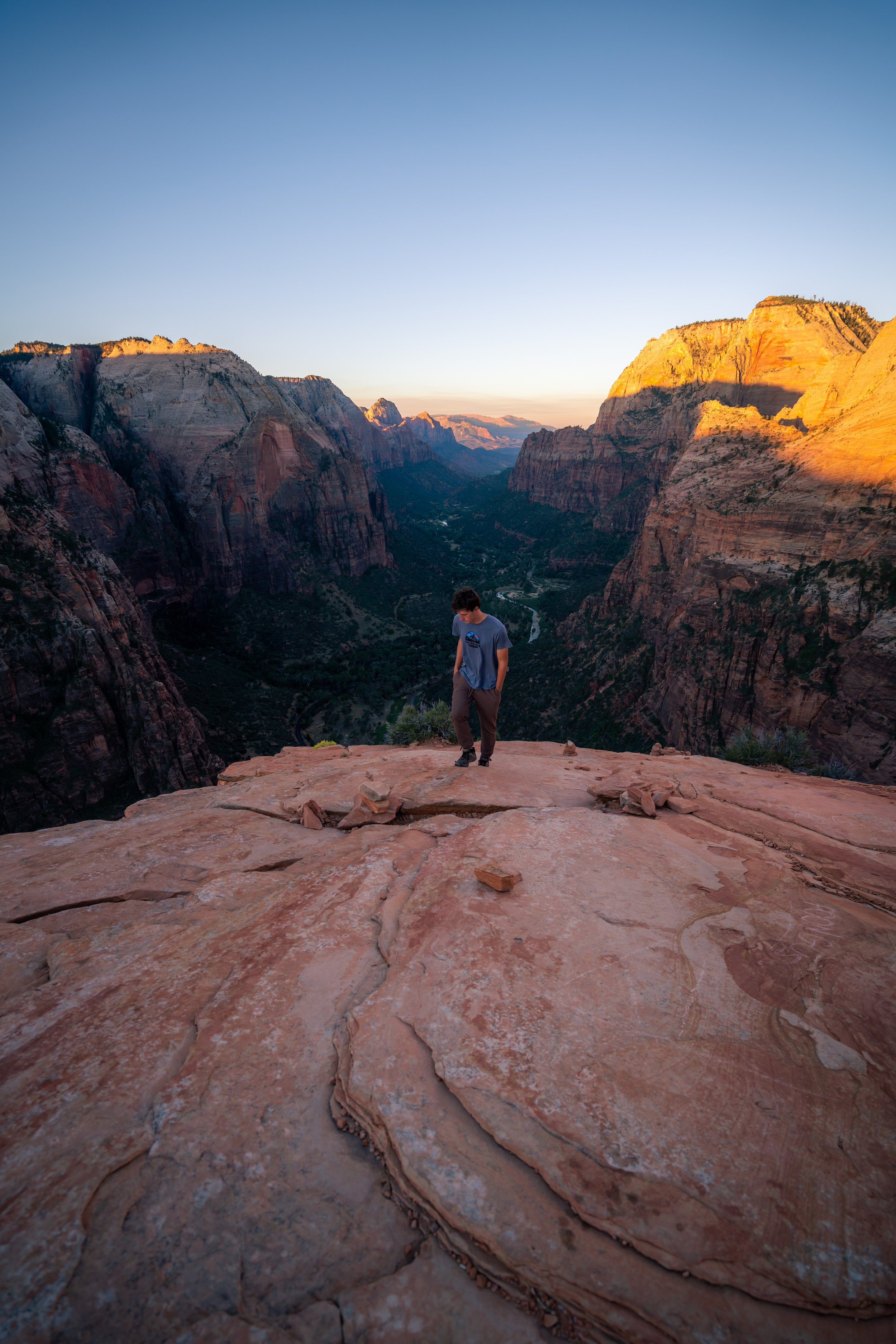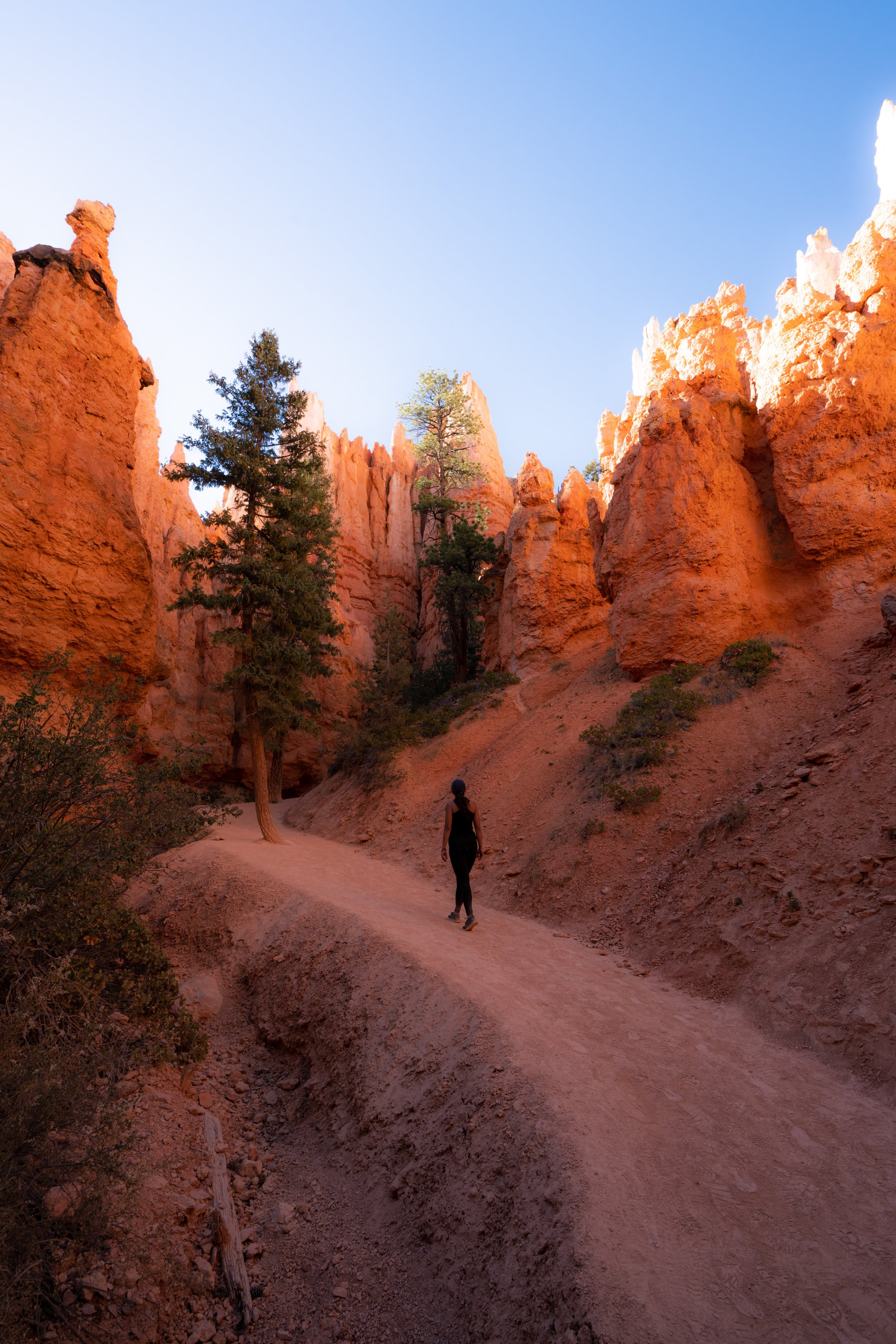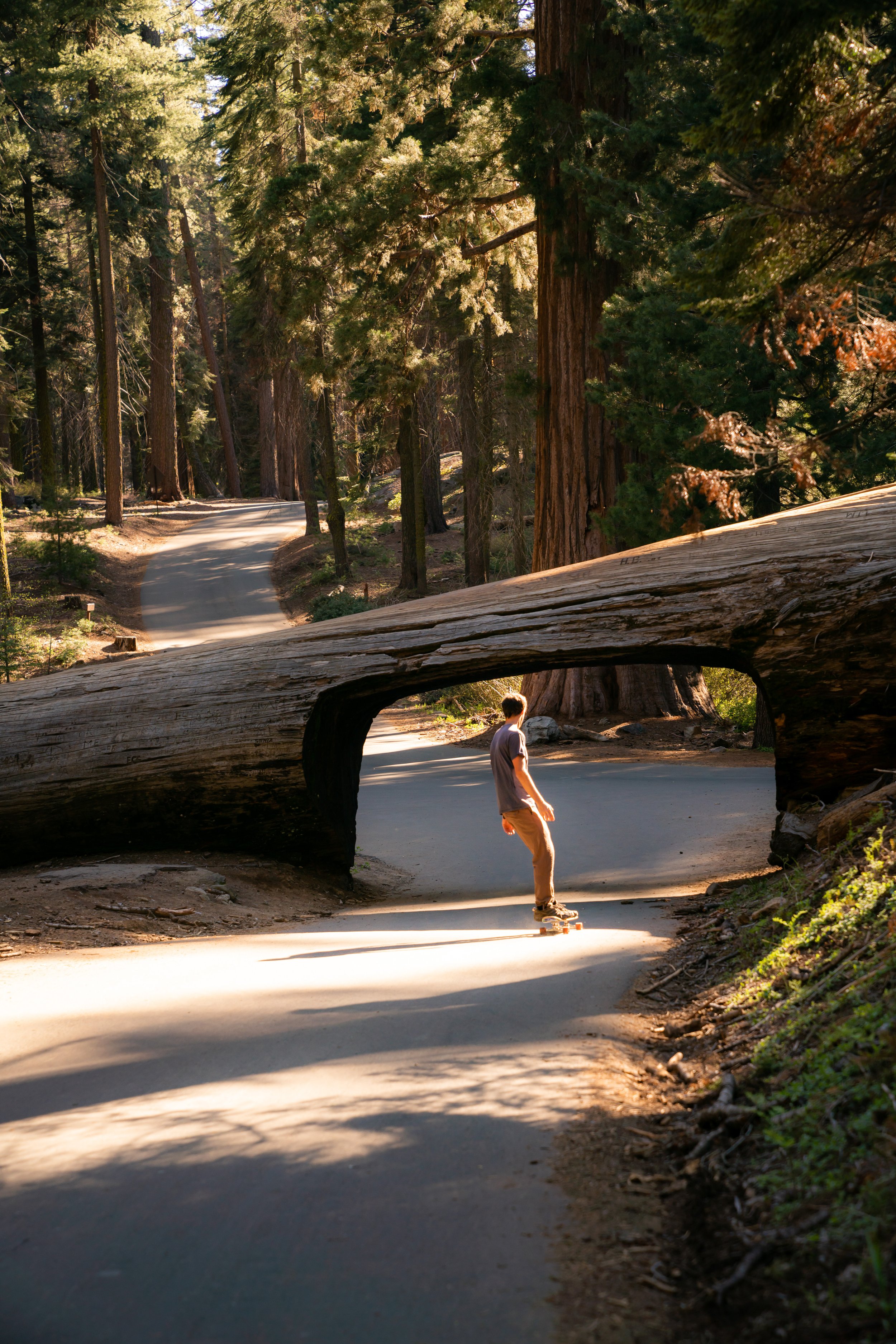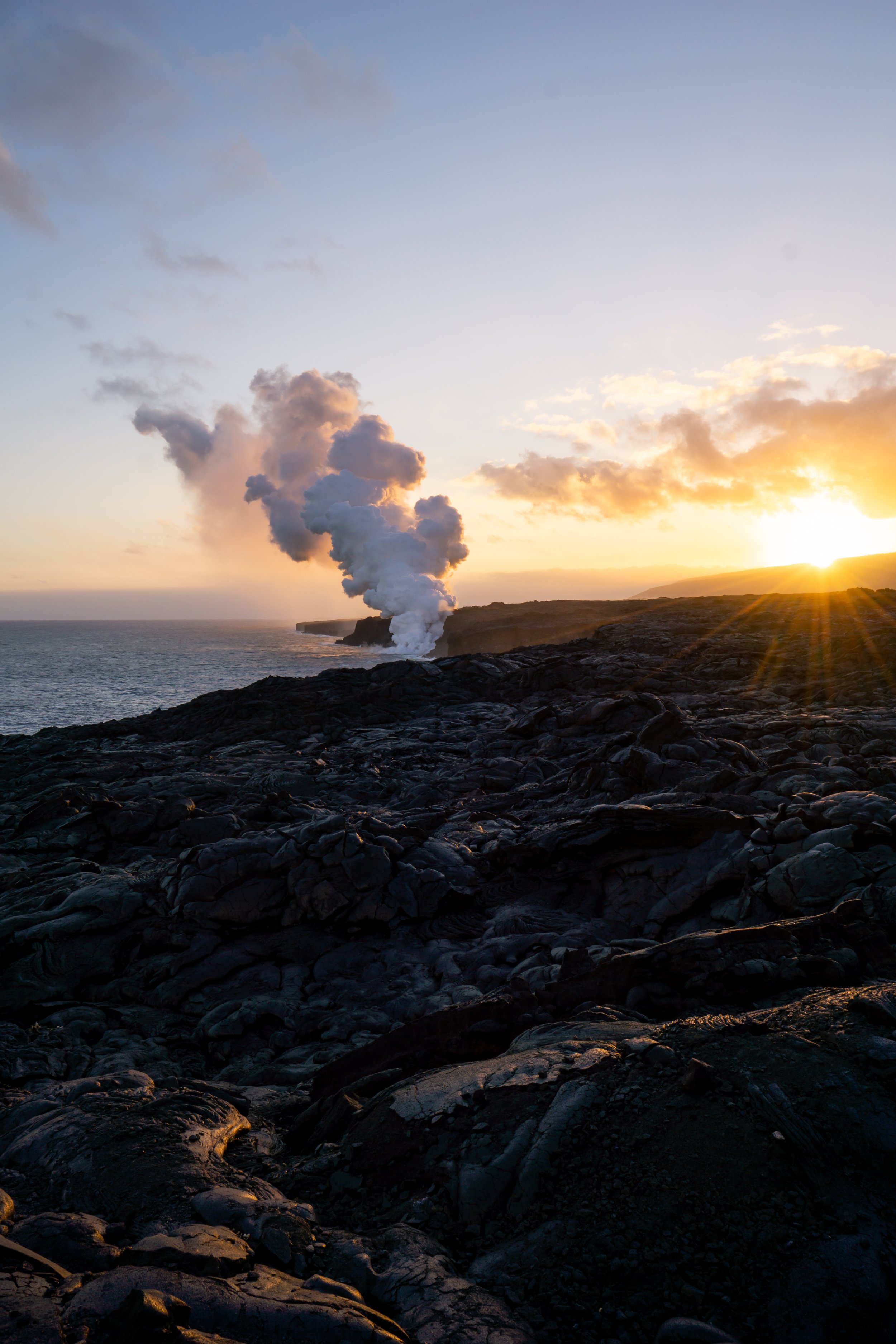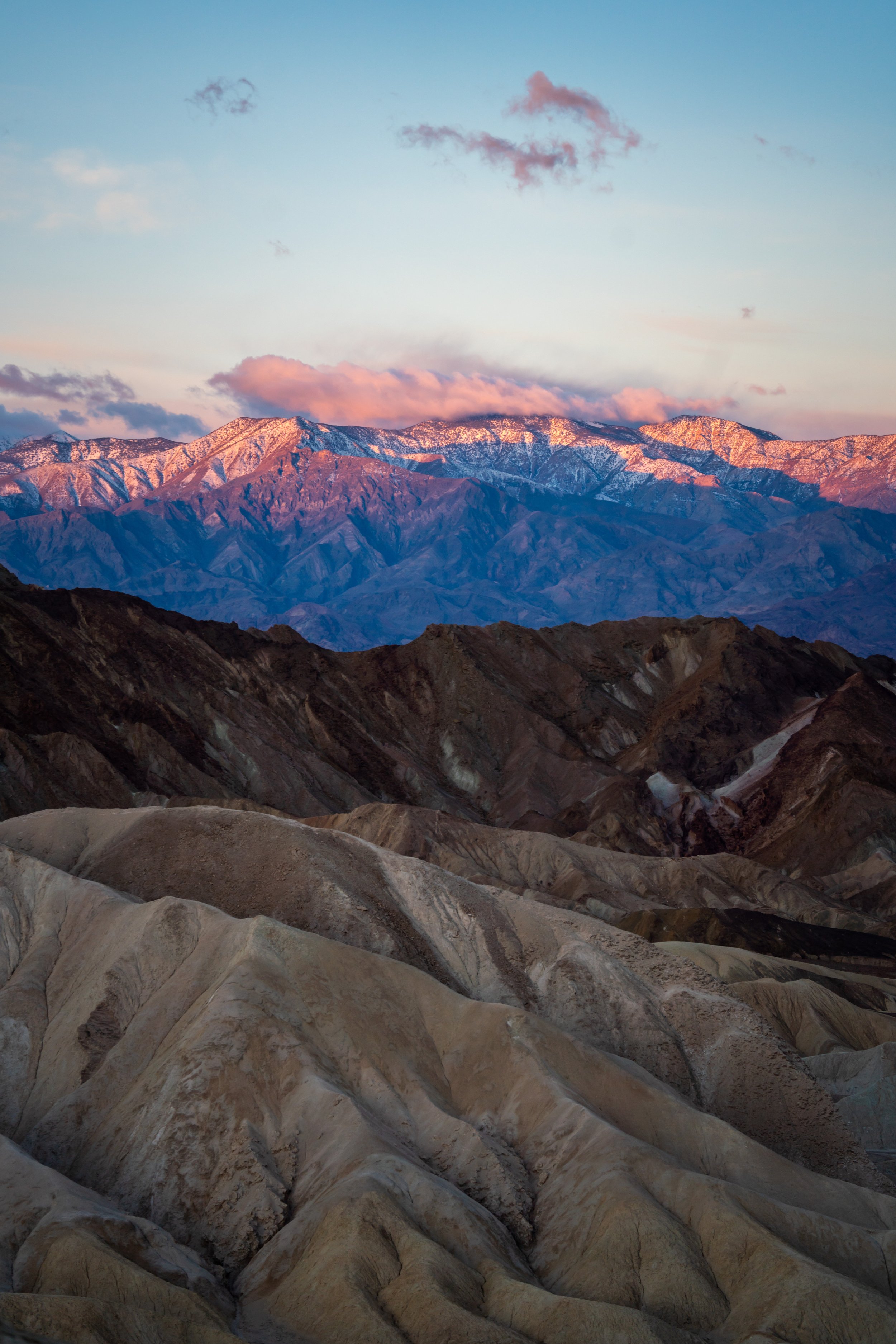Hiking the Grinnell Glacier Trail in Glacier National Park
Distance: 10.6 miles / 17.1 km
Elevation Gain: ~1,600 ft. / 488 m
The Grinnell Glacier Trail is, without a doubt, one of the best hikes in Glacier National Park, and in my opinion, it’s one of the best hikes in the country!
I believe this because, from the beautiful turquoise-blue waters of Grinnell Lake and Grinnell Falls to the opportunity to swim with icebergs at the glacier to seeing individuals walk the cliffs high above the glacier from the Highline Trail on the far side of the mountain, there are few adventures with so much diversity in just one day hike!
On top of this, the Grinnell Glacier Trail is the best day hike in Glacier National Park to see what a receding glacier looks like up close—a phenomenon happening in mountain ranges all across the Mountain West.
This is all to say, there are few day hikes as stunningly beautiful as the Grinnell Glacier Trail, and there’s truly no telling what you might encounter in terms of wildlife. For me, it was Mountain Goats and Bighorn Sheep right on the trail!
Grinnell Glacier Trailhead Parking
Parking for the Grinnell Glacier Trail is located in a very small parking lot just a little before the Many Glacier Ranger Station.
Since the parking area for Grinnell is so limited, cars typically spill out onto Many Glacier Road, where there is additional parking. Typically, this is the case on nearly every nice day during the busy summer season.
Google Maps Directions: Grinnell Glacier Trailhead
Hiking Checklist - Glacier
Here is a complete list of must-have things that you will want for any hike in Glacier National Park.
Bear Spray & Holster - If you aren’t flying, don’t rent bear spray! It’s a waste of money. Prepare ahead of time by buying your own, as this may be one of the most important items on this list.
Osprey 3L Water Bladder - The Osprey 3L water bladder is the most universal hiking and backpacking water bladder on the market, and it’s my go-to because of the slide-off seal that allows it to be quickly filled from the top. Additionally, individual parts are easily replaceable, such as the bite valve.
Black Diamond Headlamp - Personally, I recommend the Black Diamond Storm because it is one of the brightest, lightest, and longest-lasting headlamps on the market—and trust me, the weight-to-battery-life ratio really does matter!
Hiking / Trail Running Shoes - Depending on the type of trail, I prefer to use either the Keen Targhee for longer, more rugged hiking or the HOKA Zinal Trail-Running Shoe for lighter, less intense trails. In either case, both have been amazing to me for many years across countless environments, and both can be found in men’s and women’s sizes. - (Men’s Keen / Women’s Keen) (Men’s HOKA / Women’s HOKA)
Blister / Heel Protectors - I swear by these cheap, amazing heel protectors to prevent blisters for nearly every kind of hiking and backpacking that I do!
Waterproof Rain Shell - You never know when it may rain, and I’ve learned over the years that a rain shell is far better than a rain jacket. By this, I mean that it’s best to have something that the water will roll right off of, which is why I recommend the Patagonia Torrentshell 3L available in both men’s and women’s sizes.
High SPF Sunscreen - Packing high-SPF sunscreen is a must for long days outside!
Hiking the Grinnell Glacier Trail
Between Grinnell Glacier, Cracker, and Iceberg Lake, Grinnell Glacier is easily the most challenging trail that begins out of Many Glacier.
This is because the trail gains about 1,600 ft. (488 m) of elevation, which is all concentrated in the last 3.5 miles (5.6 km) of the trail where the treeline begins to thin, making the hike one of the hardest on a hot summer day, like the photos in this post.
In the beginning, the Grinnell Glacier Trail will remain mostly flat until about the last third of Lake Josephine.
Swiftcurrent-North Shore Lake Josephine Junction
There are a number of turns along the Grinnell Glacier Trail, but know that Grinnell Glacier is furthest of all destinations from the Grinnell Glacier Trailhead.
Go right at this first split to continue around Lake Josephine.
Then, go right again at the next split.
Grinnell Glacier-Grinnell Lake Junction
The next junction in the trail is for both the continued loop trail around Lake Josephine as well as the more popular Grinnell Lake, which will become more and more visible the further you hike up the Grinnell Glacier Trail.
Go right once again to continue up toward Grinnell Glacier.
At about the 1.8-mile (2.9 km) mark, the Grinnell Glacier Trail starts to noticeably gain elevation, as it rises up from Lake Josephine below.
Grinnell Glacier-Josephine Lake Boat Dock Junction
At the next split for the Lake Josephine Boat Dock, go right.
This is trail you would have come up had you taken the shuttle boat across Lake Josephine.
From this point on, there are no more notable junctions in the trail, but personally, I think that the switchbacks make for nice mental checkpoints because there are so few on the entire hike.
This is the first and likely most notable switchback on the hike up to Grinnell Glacier because the initial long stretch from Lake Josephine continues on for so long.
This is the view toward Grinnell Lake, which only gets better and better the higher the trail goes.
This waterfall pouring off Mt. Grinnell is one of the best parts about the trail on a hot summer day.
Additional Early Season Gear
Depending on the winter snowpack, micro-spikes may be necessary, as the trail reaches these more exposed sections of the hike.
This is because upper elevation trails, like the Grinnell Glacier Trail, can be covered in snow for much longer than lower areas of the park, making these sections extremely dangerous when they are snowy and icy.
On some of the most exposed sections prior to the glacier, one cannot fall, or it would certainly mean death.
I personally use the Yaktrax below.
On my return hike, this stretch of the trail is where I saw a number of mountain goats and bighorn sheep.
Just prior to the final section up Grinnell Glacier is the split for the pit toilets.
Go left to reach Grinnell Glacier, located only 0.4 miles (0.6 km) ahead.
The final uphill, after the pit toilets, seemed to drag on for much longer than it initially appeared.
However, when you reach the top, you'll have amazing views of Grinnell from atop the hill, which is shown in the photo below.
Grinnell Glacier
The Grinnell Glacier may look very different from these photos, depending on what time of the summer season that you are visiting.
These photos were taken in mid-August during an average snow year, but the amount of ice on the lake can drastically change depending on how much earlier in the season it is.
Warning
Afternoon thunderstorms in high Mountain West areas, such as this, are a serious concern during the summer monsoon season.
Even if the weather forecast doesn’t predict any storms, I can tell you from personal experience that they may show up out of nowhere and can put you and your entire group in a very dangerous situation.
I say this to emphasize the importance of turning around at the first sign of lightning, thunder, or even heavy cloud buildup. However, if you ever get caught in a storm unsuspectingly, follow the steps linked below to reduce the risk of getting struck.
U.S. Forest Service: Lightning Safety Tips
More Glacier Adventures
If you’re interested in reading about some more amazing adventures within Glacier National Park, check out my separate posts below!
Best Way to Find Places to Stay!
Wherever I travel, I love to start my search for places to stay on VRBO.
Even if I don’t end up booking through them, I think it’s one of the best ways to see what’s in the area!
Best Way to Book Rental Cars!
I travel quite a bit, and I know firsthand that finding a good rental car deal can be a challenge, but that’s why I recommend comparing all of your options with Discover Cars.
In short, Discover Cars is a well-known, reputable business that allows you to search for the best deal across companies, and they have the best full-refund cancellation policy I’ve ever seen, valid up to 72, or sometimes even 48, hours prior to your reservation!
Book Here: Discover Cars
Safety
Always be mindful that Glacier National Park and the surrounding area is Grizzly Bear country. Therefore, you need to be hiking with bear spray and know how to react in the event of a Black or Brizzly Bear encounter.
Aside from wildlife, Glacier National Park, like any area in the Mountain West, is known for its violent afternoon thunderstorms, which are more typical in the warmer summer months than other times of the year.
That said, it’s important to check the local forecast before setting off on any adventure, as lightning strikes are not uncommon in and near mountain ranges across the West. I have personally been knocked to the ground by a strike that hit near me in the past, and I confidently say that it’s an experience you don’t want to live through. This is why I highly recommend checking Mountain Forecast for any high-elevation adventures you may be interested in—especially when climbing a summit.
Finally, know that when micro-spikes are necessary for an early-season adventure, micro-spikes are never supposed to be a substitute for conditions that require crampons.
As always, find the most up-to-date information and conditions on the official National Park website.
National Park Service: Glacier National Park
U.S. National Parks Pass
Did you know that the same America the Beautiful Pass that grants access to all 63 U.S. National Parks can be purchased in advance at REI?
Yes, you can save time when you arrive by purchasing your National Park pass, along with your other outdoor gear, at REI before traveling to the park!
More U.S. National Parks
If you’d like to read more about some of my best recommendations when visiting other U.S. National Parks, check out some of my other posts below!
Disclaimer
All information provided on this blog is for informational purposes only and is not intended to be a substitute for information or advice from qualified professionals or managing agencies.
Noah Lang Photography LLC makes no representations or warranties regarding the accuracy or completeness of the information provided here, and readers should use their own discretion, judgement, and seek professional advice where it is appropriate.
Furthermore, Noah Lang Photography LLC shall not be held responsible for any injuries, lost individuals, or legal issues arising from the use of information provided on this website, and if applicable, the above safety disclaimer should be referenced to provide a generic overview of the risks involved.
All said, the content on this blog is for the sole use of Noah Lang Photography LLC, and unauthorized use or reproduction of this content is strictly prohibited.
Disclosure
This post is not sponsored.
However, some of the links in this post are affiliate links, which means that I may earn a small commission if a purchase is made through one of those links. This commission comes at no additional cost to you, and I only recommend products that I personally use and believe will add value to my readers. Thank you for your support, which enables me to continue creating more!
To read the full privacy policy, click here.

About This Blog
Noah Lang Photography, also known as @noahawaii, is 100% reader-supported!
I do not accept guest articles or sponsored content of any kind on my blog, which is why, if you enjoy the outdoor and travel content I create, please consider buying me a coffee!
I appreciate your support, which helps me continue to keep this blog alive!













